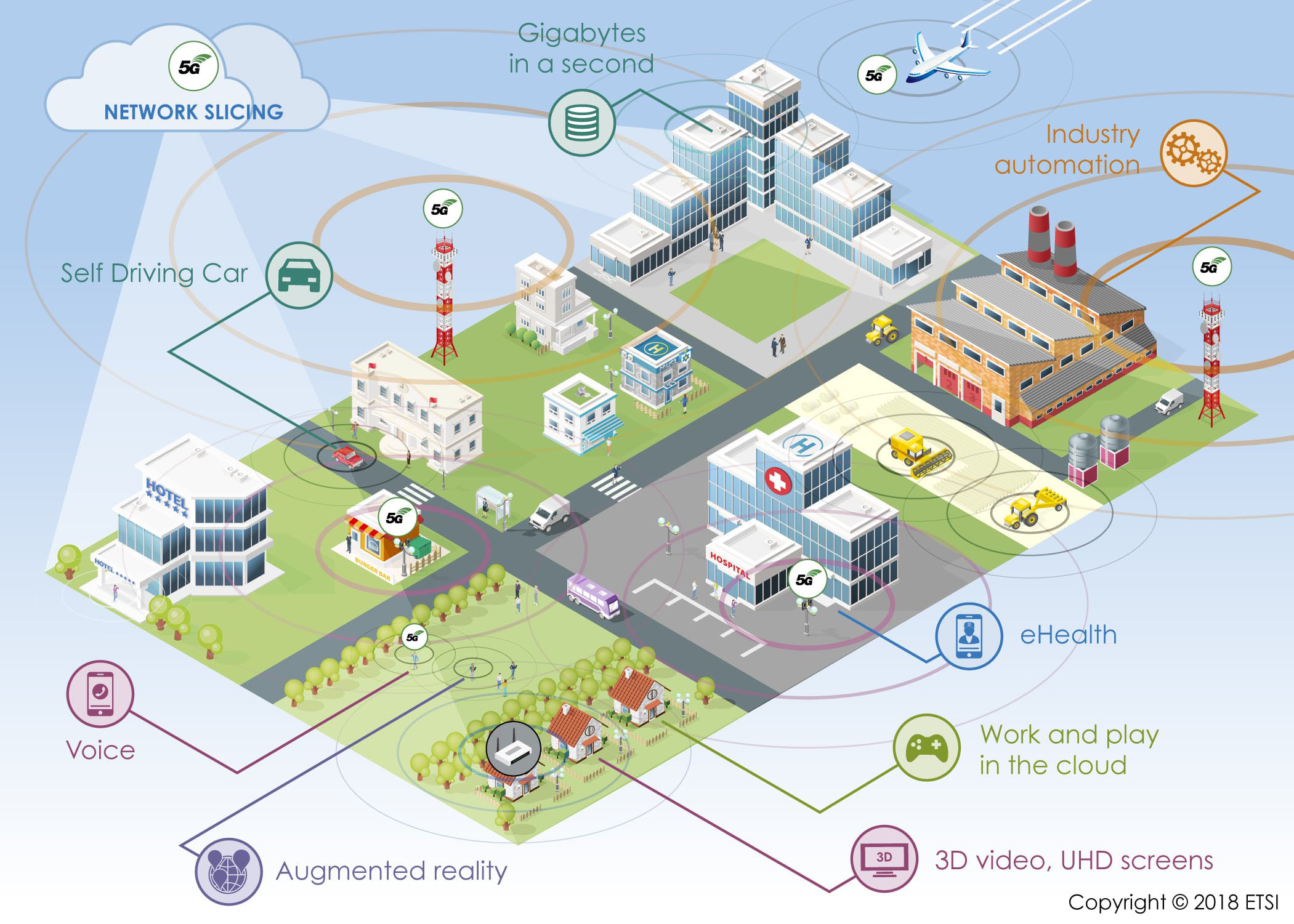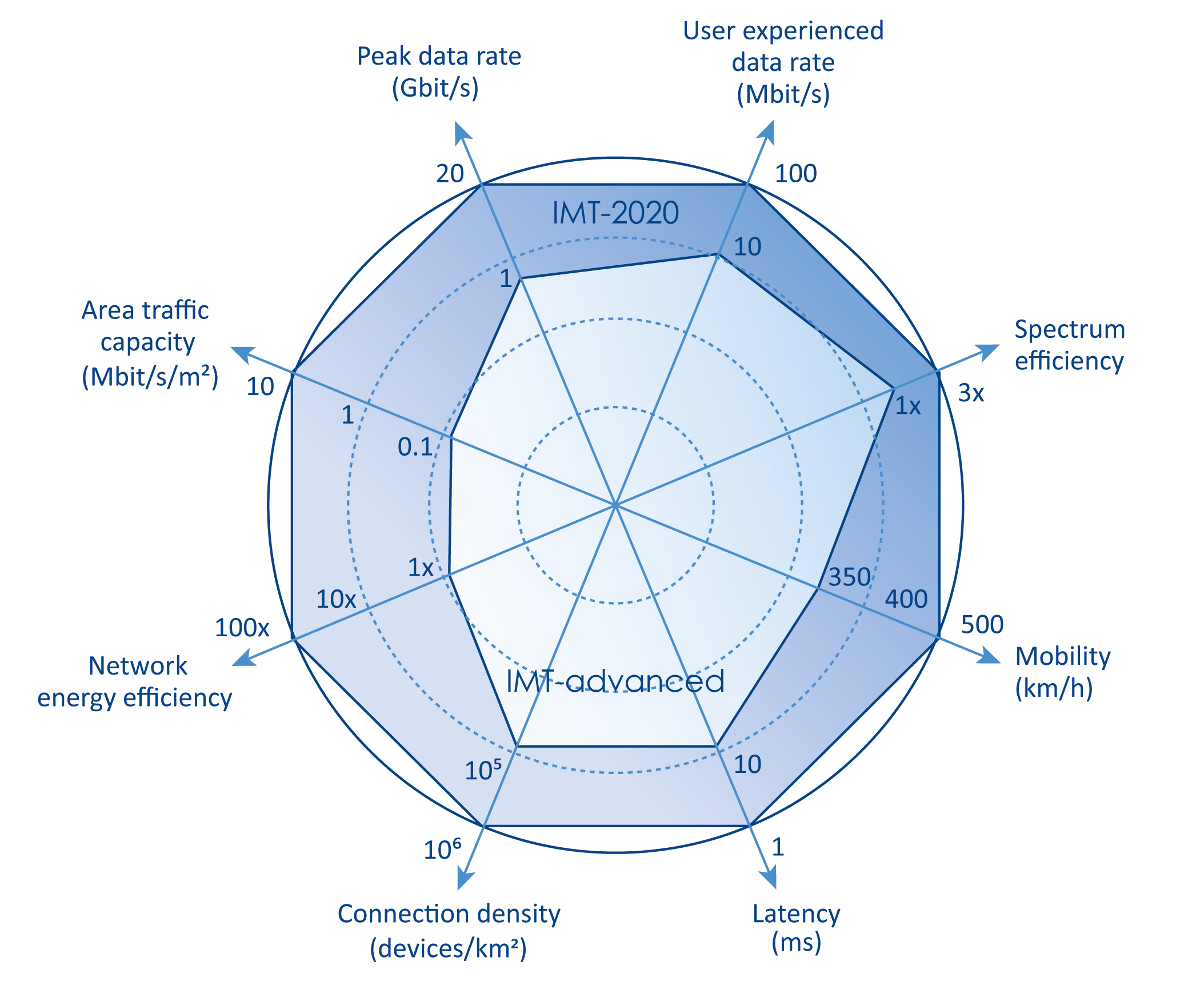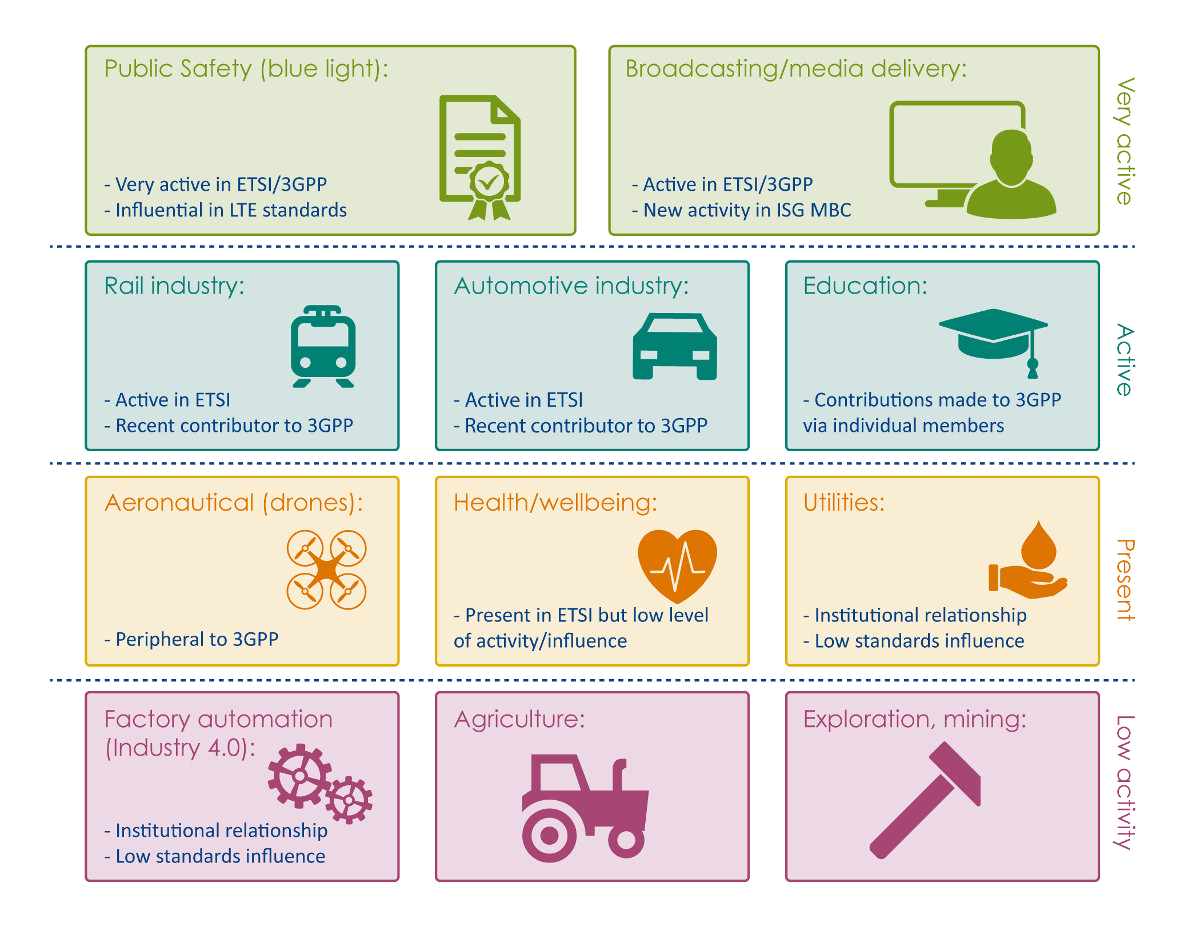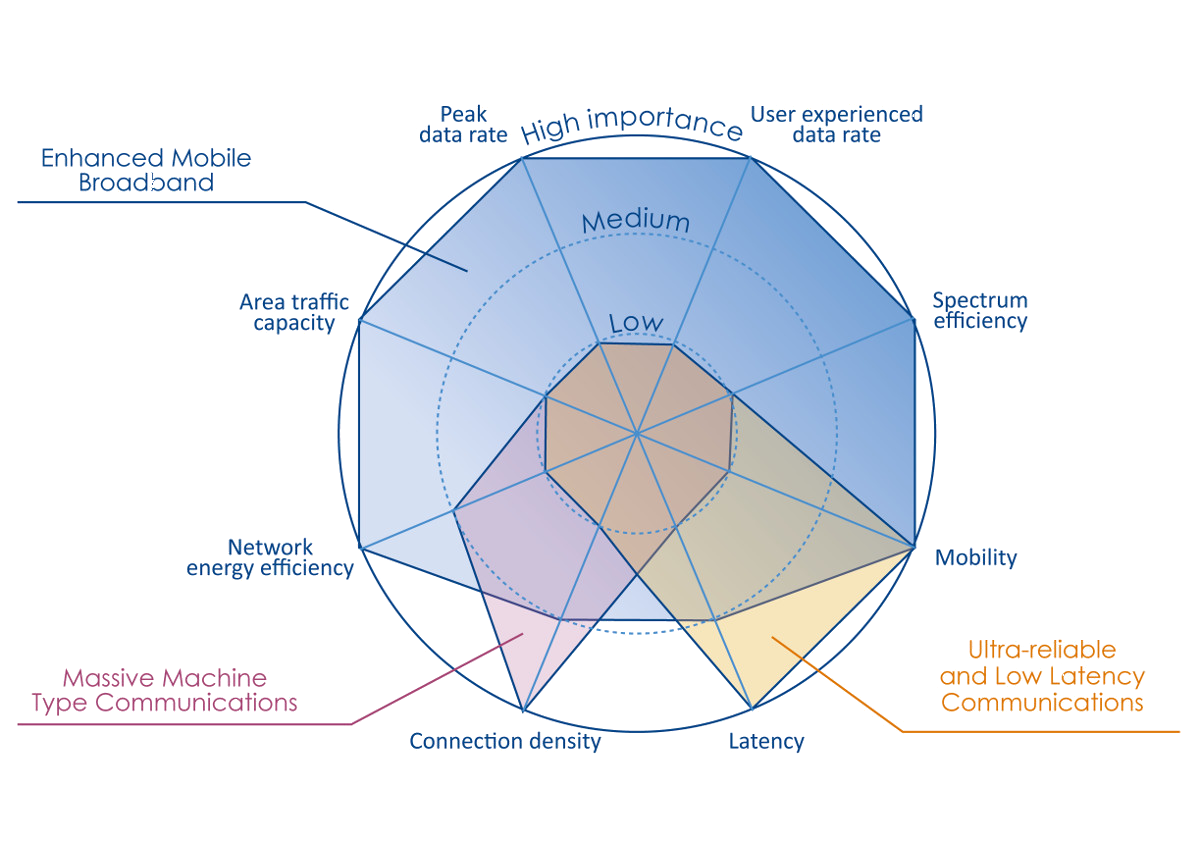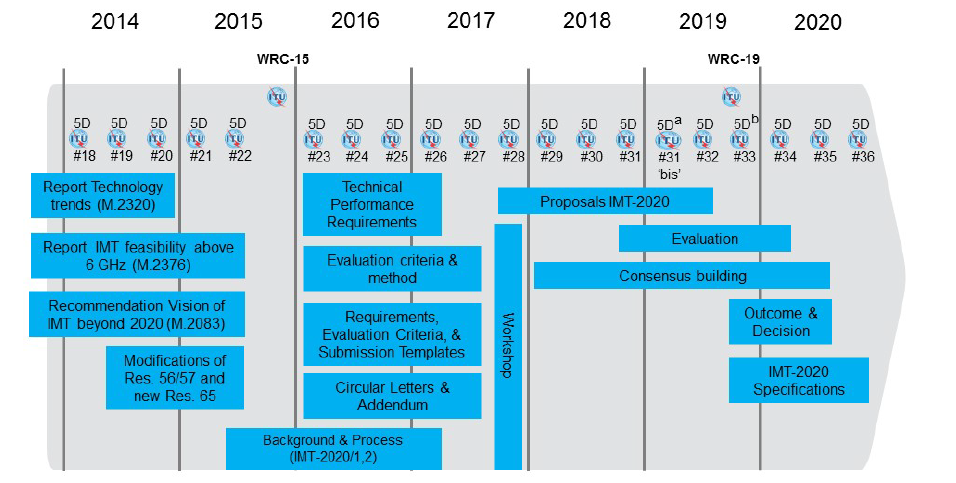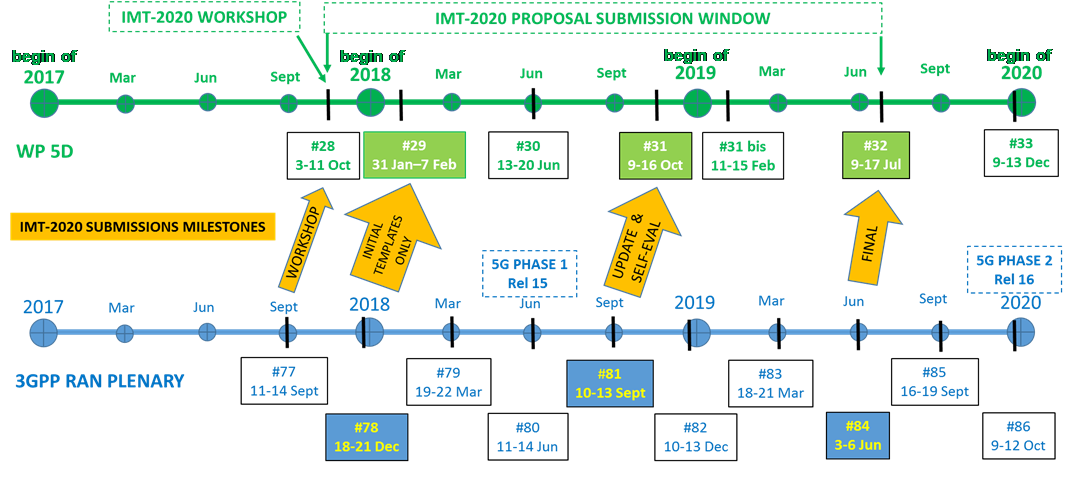Why do we need 5G?
- Mobile data traffic is rising rapidly, mostly due to video streaming.
- With multiple devices, each user has a growing number of connections.
- Internet of Things will require networks that must handle billions more devices.
- With a growing number of mobiles and increased data traffic both mobiles and networks need to increase energy efficiency.
- Network operators are under pressure to reduce operational expenditure, as users get used to flat rate tariffs and don't wish to pay more.
- The mobile communication technology can enable new use cases (e.g. for ultra-low latency or high reliability cases) and new applications for the industry, opening up new revenue streams also for operators.
So 5G should deliver significantly increased operational performance (e.g. increased spectral efficiency, higher data rates, low latency), as well as superior user experience (near to fixed network but offering full mobility and coverage). 5G needs to cater for massive deployment of Internet of Things, while still offering acceptable levels of energy consumption, equipment cost and network deployment and operation cost. It needs to support a wide variety of applications and services.
Comparison of key capabilities of IMT-Advanced (4th generation) with IMT-2020 (5th generation) according to ITU-R M.2083:
Who is interested in using 5G?
5G offers network operators the potential to offer new services to new categories of users.
What are the main usage scenarios of 5G?
ITU-R has defined the following main usage scenarios for IMT for 2020 and beyond in their Recommendation ITU-R M.2083:
- Enhanced Mobile Broadband (eMBB) to deal with hugely increased data rates, high user density and very high traffic capacity for hotspot scenarios as well as seamless coverage and high mobility scenarios with still improved used data rates
- Massive Machine-type Communications (mMTC) for the IoT, requiring low power consumption and low data rates for very large numbers of connected devices
- Ultra-reliable and Low Latency Communications (URLLC) to cater for safety-critical and mission critical applications
which requires different key capabilities according to ITU-R M.2083:
How is the 5G standard developed?
ITU-R has set up a project called IMT-2020 to define the next generation of mobile communication networks for 2020 and beyond with the following time plan:
See also the IMT-2020 schedule and IMT-2020 process.
At TSG #67 in March 2015, 3GPP formulated with SP-150149 a 3GPP timeline on how to contribute to this 5th generation of mobile networks.
In connection with RAN #69 in Sep. 2015, 3GPP held a workshop in Phoenix, USA in order to inform 3GPP about the ITU-R IMT-2020 plans and to share the visions and priorities of the involved companies regarding the next generation radio technology/ies.
The chair's summary (RWS-150073) formulated 3 next steps:
- preparation of channel modeling work for high frequencies
- a study to develop scenarios and requirementsfor next generation radio technology
- a study for RAN WGs to evaluate technology solutions for next generation radio technology
At RAN #69 in Sep.2015, 3GPP started a Rel-14 study item (FS_6GHz_CH_model, RP-160210) "Study on channel model for frequency spectrum above 6 GHz". This study completed at RAN #72 in June 2016 with the 3GPP TR 38.900.
Note 1: LTE-Advanced was so far aggregating spectrum of up to 100MHz and was so far operating in bands below 6GHz. This study looks at the frequency range 6-100GHz and bandwidths below 2GHz.
Note 2: The whole contents of this TR was later transferred into 3GPP TR 38.901 "Study on channel model for frequencies from 0.5 to 100 GHz" covering the whole frequency range.
At RAN #70 in Dec. 2015, 3GPP started already a Rel-14 study item (FS_NG_SReq, RP-160811) "Study on Scenarios and Requirements for Next Generation Access Technologies" with the goal to identify the typical deployment scenarios (associated with attributes such as carrier frequency, inter-site distance, user density, maximum mobility speed, etc.) and to develop specific requirements for them for the next generation access technologies (taking into account what is required for IMT-2020).
This study completed at RAN #74 in Dec. 2016 with the 3GPP TR 38.913 which describes scenarios, key performance requirements as well as requirements for architecture, migration, supplemental services, operation and testing.
In March 2016, ITU-R invited for candidate radio interface technologies for IMT-2020 in a Circular Letter. The overall objectives of IMT-2020 were set via ITU-R M.2083 and the requirements were provided in ITU-R M.2410 like e.g.:
The minimum requirements:
- for peak data rate: Downlink: 20 Gbit/s, Uplink: 10 Gbit/s
- for peak spectral efficiencies: Downlink: 30 bit/s/Hz, Uplink: 15 bit/s/Hz
- user plane latency (single user, small packets): 4 ms for eMBB, 1 ms for URLLC
- control plane latency (idle => active): 10-20ms
Other requirements:
- maximum aggregated system bandwidth: at least 100 MHz, up to 1GHz in higher frequency bands (above 6GHz)
- mobility: up to 500km/h in rural eMBB
At RAN #71 in March 2016, 3GPP started a Rel-14 study item (FS_NR_newRAT, RP-170379) "Study on New Radio (NR) Access Technology" with the goal to identify and develop the technology components to meet the broad range of use cases (including enhanced mobile broadband, massive MTC, critical MTC) and the additional requirements defined in 3GPP TR 38.913. This study completed at RAN #75 in March 17 with the Rel-14 3GPP TR 38.912 which is a collection of features for the new radio access technologies together with the studies of their feasibility and their capabilities.
Note: Included in this study item were also some RAN Working Group (WG) specific 3GPP internal TRs: 38.802 (RAN1), 38.804 (RAN4), 38.801 (RAN3), 38.803 (RAN4).
At RAN #75 in March 2017, 3GPP started a Rel-15 work item (NR_newRAT, RP-181726) on "New Radio Access Technology". Over time this WI got split into 3 phases addressing different network operator demands:
- "early Rel-15 drop": focus on architecture option 3, also called non-standalone NR (NSA NR) which could be considered as the first migration step of adding NR base stations (called gNB) to an LTE-Advanced system of LTE base stations (eNB) and an evolved packet core network (EPC) i.e. in this option no 5G core network (5GC) is involved; functional freeze: Dec.2017, ASN.1 freeze in March 2018;
- "regular Rel-15 freeze": focus on the standalone NR architecture option 2 which would be a network of NR base stations (gNB) connected to the 5G core network (5GC) without any LTE involvement; functional freeze: June 2018; ASN.1 freeze in Sep.2018;
Note: Originally all other architecture options were supposed to be completed in this regular freeze phase as well. However, due to the extremely challenging time plan apart from option 2 only architecture option 5 (an LTE base station can be connected to a 5GC) was completed in this phase as well.
- "late Rel-15 drop": architecture option 4 (this would be like adding an LTE base station to an SA NR network where the control plane is handled via the NR base station) and architecture option 7 (this would be like adding an LTE base station to an SA NR network where the control plane is handled via the LTE base station) plus NR-NR Dual Connectivity; functional freeze: Dec.18; ASN.1 freeze in March 2019.
Note 1: Illustrations of the different architecture options can be found in 3GPP TR 38.801 (with the caveat that the terminology was not yet stable during this study phase).
Note 2: Rel-15 is distinguishing 2 frequency ranges: FR1: 450 MHz – 6000 MHz and FR2: 24250 MHz – 52600 MHz; while LTE is operating only in FR1, NR can operate in FR1 and FR2; FR1 is considered for NSA NR and FR2 is considered for SA NR.
As LTE-Advanced can fulfill parts of the IMT-2020 requirements for certain use cases the 3GPP input (called "5G") to IMT-2020 has 2 submissions:
- SRIT (set of radio interface technologies): component RIT NR + component RIT E-UTRA/LTE (incl. standalone LTE, NB-IoT, eMTC, and LTE-NR Dual Connectivity)
- RIT (radio interface technology) NR
Note: The terms RIT and SRIT are discussed and explained in RP-171584.
When was the 5G standard ready?
Splitting Rel-15 into multiple drops turned out to be very challenging, e.g.
- NSA NR had still non-backward compatible Change Requests in Sep.2018
- inserting ASN.1 into an already frozen specification requires very high quality change requests which is difficult under high time pressure
- WGs that require stable pre-work from other WGs (like RAN4 for RF/RRM and RAN5 for Testing) are working on instable grounds and struggle even more to stay in the time plan
Nevertheless, 3GPP contributed in time to the IMT-2020 schedule shown below:
- in Jan. 2018 via PCG40_11 with initial characteristics of the NR RIT and NR+LTE SRIT
- in Sep./Oct.2018 via PCG41_08 with the characteristics of the NR RIT and NR+LTE SRIT, the preliminary self-evaluation and link budget results and the compliance templates
- in June 2019 via PCG43_07 with the 3GPP 5G candidate submissions of NR RIT and NR+LTE SRIT including characteristics, compliance and link budget templates and the 3GPP self evaluation TR 37.910 (this submission includes further Rel-16 enhancements) to step 3 of the IMT-2020 process
Note: The characteristics templates give a good overview about the considered technology. - in June 2020 the final overviews of the 3GPP specifications via PCG45_07 for NR+LTE SRIT and PCG45_08 for NR RIT and in July 2020 the final specification sets of 2020-06 (Release 15 & 16) for the transposition of the 3GPP OPs
Further 5G Enhancements
Rel-16 considered e.g. the following NR enhancements:
- eNB(s) Architecture Evolution for E-UTRAN and NG-RAN
- Enhancements on MIMO for NR
- NR positioning support
- 5G V2X with NR sidelink
- Cross Link Interference handling and Remote Interference Management for NR
- NR-based access to unlicensed spectrum
- 2-step RACH for NR
- L1 enhancements for NR Ultra-Reliable and Low Latency Communication (URLLC)
- UE Power Saving in NR
- NR mobility enhancements
- Multi-RAT Dual-Connectivity and Carrier Aggregation enhancements (LTE, NR)
- Integrated access and backhaul for NR
- Single Radio Voice Call Continuity from 5G to 3G
- Optimisations on UE radio capability signalling – NR/E-UTRA Aspects
- Support of NR Industrial Internet of Things (IoT)
- Private Network Support for NG-RAN
- NG interface usage for Wireless Wireline Convergence
- RF requirements for NR frequency range 1 (FR1)
- Add support of NR DL 256QAM for frequency range 2 (FR2)
- NR RF requirement enhancements for frequency range 2 (FR2)
- Self-Organising Networks and Minimization of Drive Tests support for NR
- NR support for high speed train scenario
- RRM requirement for CSI-RS based L3 measurement in NR
- NR RRM enhancement
- Transfer of Iuant interface specifications from 25-series to 37-series
- Direct data forwarding between NG-RAN & E-UTRAN nodes for inter-system mobility
- Introduction of capability set(s) to the multi-standard radio specifications
The Rel-16 stage 3 and ASN.1 freeze was carried out in June 2020.
Rel-17 considered e.g. the following NR enhancements:
- Further enhancements on MIMO for NR
- NR Sidelink enhancement
- NR Dynamic spectrum sharing (DSS)
- Enhanced Industrial Internet of Things (IoT) and ultra-reliable and low latency communication (URLLC) support for NR
- Solutions for NR to support non-terrestrial networks (NTN)
- UE power saving enhancements for NR
- NR multicast and broadcast services
- Enhancements to Integrated Access and Backhaul (IAB) for NR
- NR small data transmissions in INACTIVE state
- Multiple Input Multiple Output (MIMO) Over-the-Air (OTA) requirements for NR UEs
- Enhancement of Private Network support for NG-RAN
- Introduction of DL 1024QAM for NR FR1
- Enhanced NR support for high speed train scenario for frequency range 1 (FR1)
- NR support for high speed train scenario in frequency range 2 (FR2)
- Further enhancements of NR RF requirements for frequency range 2 (FR2)
- RF requirements enhancement for NR frequency range 1 (FR1)
- NR positioning enhancements
- NR coverage enhancements
- Support of reduced capability NR devices
- NR repeaters
- Introduction of bandwidth combination set 4 (BCS4) for NR
- NR Sidelink Relay
- NR Uplink Data Compression (UDC)
- Enhancement of RAN slicing for NR
- NR QoE management and optimizations for diverse services
- Introduction of UE TRP (Total Radiated Power) and TRS (Total Radiated Sensitivity) requirements and test methodologies for FR1 (NR SA and EN-DC)
- Introduction of UE high power classes (1.5 and 2) for various bands and Carrier Aggregation combinations
- Introduction of various new bands and Carrier Aggregation/Dual Connectivity band combinations
The Rel-17 stage 3 was frozen in March 2022 and Rel-17 ASN.1 freeze was carried out in June 2022.
A revised input to IMT-2020 (i.e. ITU-R Recommendation M.2150 rev.2) was provided from RAN #98e in Dec.2022 in RP-223440 for the SRIT and RP-223441 for the RIT. Dec.2022 REL-17 specifications were used as inputs to the transposition.
Although most RAN1/2/3 led Rel-18 features were already approved in Dec.2021 and further RAN4 led Rel-18 features were approved in March 2022, the WGs focused on the Rel-17 completion and started Rel-18 work in RAN1 only after March 2022 and in RAN2/3/4 only after June 2022.
Rel-18 considered e.g. the following NR enhancements:
- Expanded and improved NR positioning
- Further NR mobility enhancements
- NR NTN (Non-Terrestrial Networks) enhancements
- Enhancement of NR Dynamic Spectrum Sharing (DSS)
- Multi-carrier enhancements for NR
- Further NR coverage enhancements
- NR MIMO evolution for downlink and uplink
- NR sidelink evolution
- NR network-controlled repeaters
- Enhanced support of reduced capability NR devices
- Network energy savings for NR
- Mobile Terminated-Small Data Transmission (MT-SDT) for NR
- Dual Transmission/Reception (Tx/Rx) Multi-SIM for NR
- NR sidelink relay enhancements
- In-Device Co-existence (IDC) enhancements for NR and MR-DC
- NR support for UAV (Uncrewed Aerial Vehicles)
- Enhancements of NR Multicast and Broadcast Services
- XR (eXtended Reality) enhancements for NR
- Further enhancement of data collection for SON (Self-Organising Networks)/MDT (Minimization of Drive Tests) in NR standalone and MR-DC (Multi-Radio Dual Connectivity)
- Enhancement on NR QoE management and optimizations for diverse services
- Mobile IAB (Integrated Access and Backhaul) for NR
- Artificial Intelligence (AI)/Machine Learning (ML) for NG-RAN
- NR Timing Resiliency and URLLC enhancements
- Network Slicing Phase 3: NR aspects
- Non-Public Networks Phase 2: NG-RAN aspects
- Enhanced NR support for high speed train scenario in frequency range 2 (FR2)
- NR support for dedicated spectrum less than 5MHz for FR1
- Further RF requirements enhancement for NR and EN-DC in frequency range 1 (FR1)
- NR RF requirements enhancement for frequency range 2 (FR2), Phase 3
- Requirement for NR frequency range 2 (FR2) multi-Rx chain DL reception
- Even Further RRM enhancement for NR and MR-DC
- Further enhancements on NR and MR-DC measurement gaps and measurements without gaps
- BS/UE EMC enhancements for NR and LTE
- Air-to-ground network for NR
- Support of intra-band non-collocated EN-DC/NR-CA deployment
- NR demodulation performance evolution
- Enhancement of Multiple Input Multiple Output (MIMO) Over-the-Air (OTA) requirement for NR UEs
- Enhancement of UE TRP (Total Radiated Power) and TRS (Total Radiated Sensitivity) requirements and test methodologies for FR1 (NR SA and EN-DC)
- Complete the specification support for BandWidth Part operation without restriction in NR
- NR channel raster enhancement
- Introduction of UE high power classes (1.5 and 2) for various bands and Carrier Aggregation combinations
- Introduction of various new bands and Carrier Aggregation/Dual Connectivity band combinations
The RAN Rel-18 stage 3 freeze was in December 2023 and a corresponding Rel-18 ASN.1 freeze is intended for June 2024.
3GPP also contributed to the satellite component of IMT-2020:
- in Dec.2023 via RP-233981) with characteristics, compliance and link budget template for the RIT NR NTN and the SRIT NR NTN + LTE related IoT NTN (NB-IoT/eMTC satellite access) which were both based on REL-17 functionality.
- Corresponding evaluation happened in the RAN led REL-18 study item "Study on self-evaluation towards the IMT-2020 submission of the 3GPP Satellite Radio Interface Technology" (FS_IMT2020_SAT_eval) which is documented in 3GPP TR 37.911.
A revised input to IMT-2020 (i.e. ITU-R Recommendation M.2150 rev.3), i.e. the terrestrial version, is planned using Dec.2024 REL-18 specifications.
Most RAN1/2/3 led Rel-19 features were approved in Dec. 2023 (see list below) and further RAN4 led Rel-19 features are planned for March 2024 and June 2024. RAN2/3/4 will still work on REL-18 completion so their REL-19 work will only start after March 2024.
Rel-19 considered e.g. the following NR enhancements:
- NR MIMO Phase 5
- Evolution of NR duplex operation: Sub-band full duplex (SBFD)
- Artificial Intelligence (AI)/Machine Learning (ML) for NR air interface
- Low-power wake-up signal and receiver for NR (LP-WUS/WUR)
- Enhancements of Network energy savings for NR
- NR mobility enhancements Phase 4
- Non-Terrestrial Networks (NTN) for NR Phase 3
- XR (eXtended Reality) for NR Phase 3
- Data collection for SON (Self-Organising Networks)/MDT (Minimization of Drive Tests) in NR standalone and MR-DC (Multi-Radio Dual Connectivity) Phase 4
Like with GERAN, UMTS and LTE in the past, 5G will be further evolved in the future to address the industry and customer demands.
Note: The description above is focussing on RAN work items and radio aspects but of course corresponding core network and system aspects were required and standardized as well. See the 3GPP workplan for a complete picture.
Where to find the corresponding 5G specifications?
A list of all 5G related specs (incl. core network and system aspects) is provided in 3GPP TR 21.205 or use this URL on the 3GPP website.
Radio related specifications addressing only NR: 38 series specifications.
Radio related specifications addressing only LTE: 36 series specifications.
Radio related specifications addressing aspects affecting both LTE and NR: 37 series specifications.
Service requirements for next generation new services and markets: 3GPP TS 22.261.
System Architecture for the 5G system (stage 2): 3GPP TS 23.501.
Procedures for the 5G System (stage 2): 3GPP TS 23.502.
NR; NR and NG-RAN Overall Description (stage 2): 3GPP TS 38.300.
NR; Multi-connectivity; Overall description (stage 2): 3GPP TS 37.340.
NG-RAN; Architecture description: 3GPP TS 38.401.
ETSI's 5G Building Blocks
ETSI has a number of component technologies which will be integrated into future 5G systems: Network Functions Virtualization (NFV), Multi-access Edge Computing (MEC), Millimetre Wave Transmission (mWT) and Non-IP Networking (NIN).

